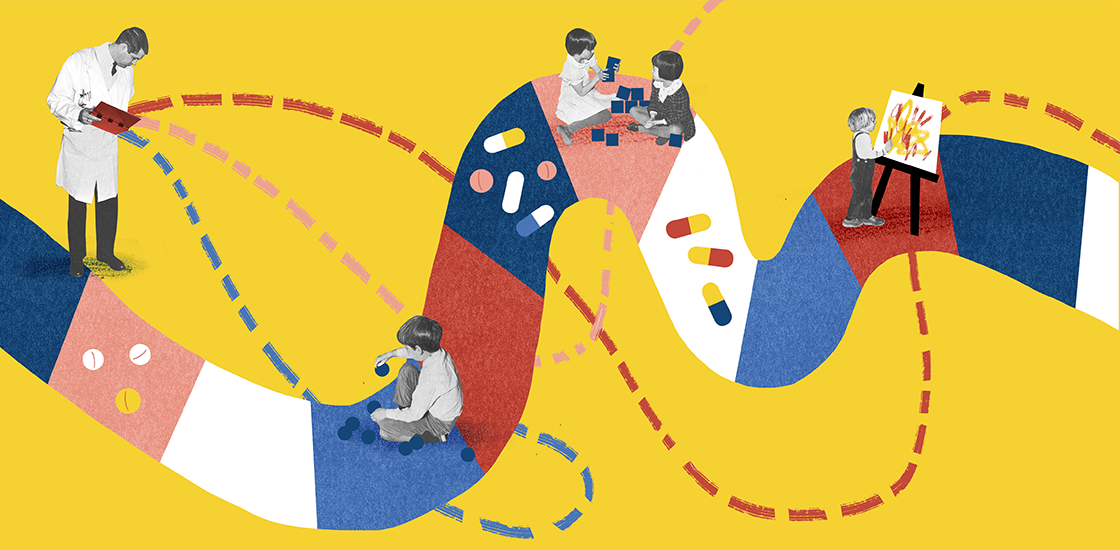Most autistic children in the Netherlands — almost 90 percent — have used some sort of treatment, such as behavioral therapy or medication, according to a new study. But factors unrelated to their autism traits — including IQ and their parents’ education — better predict the number, type and timing of those interventions, the study also shows.
“Interventions for autism, like treatments for many health conditions, are dependent on cultural factors as well as the health condition itself,” says Daniel Coury, professor of pediatrics and psychiatry at Ohio State University, who is based at Nationwide Children’s Hospital in Columbus, Ohio. Coury was not involved in the work.
Autistic children with co-occurring conditions tend to use more therapies than other autistic children do, the study reveals. That result underscores the importance of transdiagnostic treatments — those that address multiple issues — to help avoid fragmented care from multiple treatment providers, says study investigator Elisa Back, associate professor of psychology at Kingston University London in the United Kingdom. “Using a more transdiagnostic or holistic approach could be more efficient timewise and maybe resource-wise as well.”
The study’s findings might not be generalizable because they rely on data from a Netherlands autism database, Coury says. The Dutch health-care system provides universal coverage, whereas under the U.S. system, almost 10 percent of the population remains uninsured. Still, “Overall, the study provides results that are consistent with most similar studies,” Coury says.
B
ack and her colleagues analyzed data from 1,464 autistic children in the Netherlands Autism Register, an online repository of standardized test results and child- or parent-responses to questionnaires that assess the children’s social skills, intervention use, sensory issues and other traits.Most children — 88 percent — have used some type of intervention, which Back and her colleagues sorted into three categories: “guideline” interventions, such as psychoeducation and early intensive interventions that are specific to autism; “mainstream” interventions, such as medication and behavioral therapies directed at co-occurring issues, including anxiety and attention-deficit/hyperactivity disorder; and alternative therapies, such as unproven diets. Almost half of the children take medication, whether alone or in combination with other interventions.
The older the child and the higher their IQ, the more likely they or their parents were to report using mainstream or guideline interventions. This pattern was seen in both girls and boys. Plus, children who have co-occurring conditions or are in special education tend to use more interventions, particularly mainstream ones, than autistic children who don’t tick either of those boxes. The study was published in June in Autism.
The more education the parents have, the less their child tends to use mainstream medications, Back and her team found. Conversely, lower education was related to greater use of mainstream medications. It is surprising that higher parental education was not also linked to increased use of alternative therapies, Coury says, as past studies have suggested that many parents — particularly highly educated ones — try alternative treatments.
Surprisingly, almost none of the autism-specific factors the team evaluated — such as social difficulties or repetitive behaviors — predicted intervention use. Only sensory differences — sensitivity to sound, smell or movement, for example — showed a link: The more sensory differences an autistic child has, the more likely they are to have taken alternative medication, such as supplements and homeopathic medications.
The findings imply that some groups of children are less likely to report using guideline interventions, which are autism-specific, Back says. “Guideline interventions should be available and accessible for children of all ages, genders, and all levels of intelligence.”
A
utistic children with a lower IQ tend to use fewer interventions overall, and fewer autism-specific ones, than other autistic children — a finding Back and her team say is especially important.Specifically, “it seems like if [autistic children] have lower cognitive functioning, they may not be accessing social interventions,” Back says.
Many existing autism-specific interventions might not be designed to support children with low IQs, Back and her colleagues write, citing a review illustrating that most social-skills groups are suited to children with an IQ over 70. If a social-skills group requires the ability to follow stories, for example, it might be hard for a child with a low IQ to fully participate.
“We don’t know as much about what is effective with kids who are intellectually disabled or minimally verbal, because most people exclude them from research studies,” says Connie Kasari, professor of human development and psychology at the University of California, Los Angeles, who was not involved in the study. “They may be getting fewer effective interventions because there are fewer.”
Rather than coming up with new interventions, more research should focus on who gets interventions and when, Kasari says. “What we need to do is think for whom an intervention would work best, at what stage in their life, and why that intervention would be important. Those are the questions we need to tackle.”





